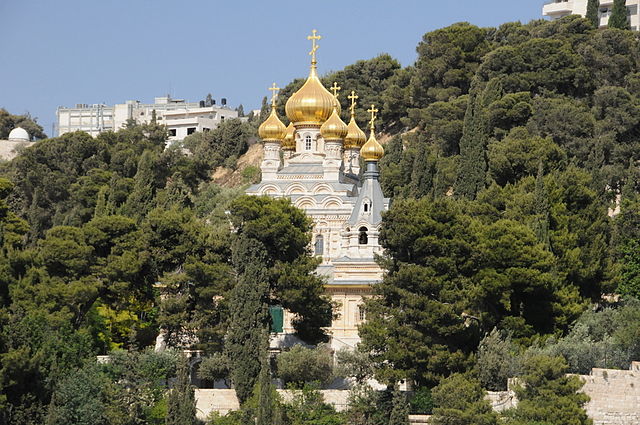 |
| The St. Mary Magdalene Convent in the Garden of Gethsemane, Mount of Olives, Jerusalem. |
The Church of Saint Mary Magdalene is situated on the slope of the Mount of Olives in the Garden of Gethsemane and is one of the most easily recognizable landmarks of Jerusalem. This striking example of Russian architecture was built in the Muscovite style with golden onion domes or cupolas.
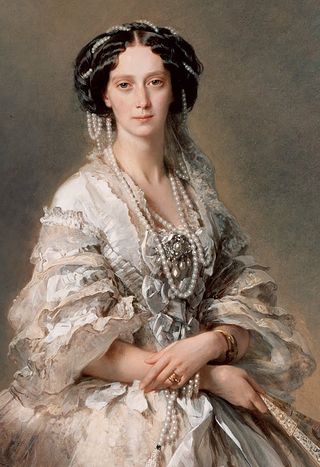
|
The Grand-Duchess took a deep personal interest in the church and commissioned the well-known Russian artist Sergei Ivanov (1864-1910) to paint the large imposing murals depicting the life of Saint Mary Magdalene which were brought to Jerusalem for the consecration and hang in the church today.
The large canvas above the iconostasis shows Mary Magdalene before the Roman Emperor Tiberius. In her hand she holds a red egg which she presents to the Emperor, symbolizing the resurrection and eternal life. She tells Tiberius about the unjust judgment and death on the cross of Jesus Christ. It is known that after re-examining this unlawful trial Pilate, at that time governor of Jerusalem, was deposed and sent into exile. The elegant white marble and bronze iconostasis holds icons by the distinguished Russian artist, Vereshchaguin.
On the right side of the iconostasis in a specially carved wooden icon-case is the miracle-working icon of the Mother of God ‘HODIGITRIA’. This icon comes from Lebanon. Records of its miracles date back to the 16th century when it miraculously survived a fire that consumed the church. Later it healed many people during a cholera epidemic.
In this century, the metropolitan of Lebanon had repeated dreams telling him to give the icon of the Hodigitria to Abbess Mary in Palestine. After some inquiries he found Abbess Mary at the Russian Orthodox Convent of Saint Mary Magdalene in Gethsemane, and this is how the icon came to be in the Church. To this day believers receive miraculous help from the Mother of God after praying before Her holy icon.
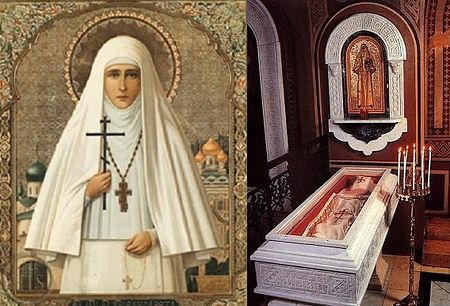 |
| Holy Royal Martyr Grand Duchess Elizabeth Feodorovna. At right is shown her reliquary in the Gethsemane Convent of St. Mary Magdalene. |
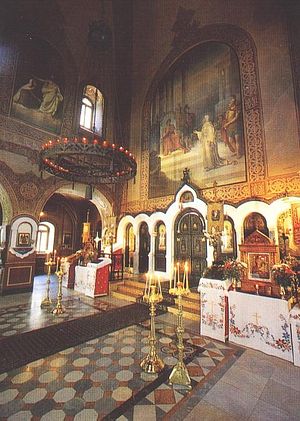 |
| The interior of the Convent Church of St. Mary Magdalene |
The church stands in the Garden of Gethsemane, the place where Jesus spent His last night on earth. Also found on the convent grounds are the remnants of a pre-Roman road, the biblical entry to Jerusalem. Not far from this road is a large stone on to which the Mother of God dropped her cincture to Apostle Thomas on the third day following her Dormition.
There are many caves in the Garden of Gethsemane which the Church tells us were used by Christ and his Disciples for prayer. One large cave in the grounds of the convent is used as a chapel, where the sisters meet to read their evening prayer rule.
Today, the church is the place of daily worship for the women’s convent of St. Mary Magdalene, under the jurisdiction of the Russian Orthodox Church Abroad. The sisterhood was established in 1936 by Mother Mary (Robinson), an English convert to Orthodoxy. The convent is a thriving community of 30 nuns from all over the world: Russians, Americans, Australians, Arabs, Serbs and Romanians.
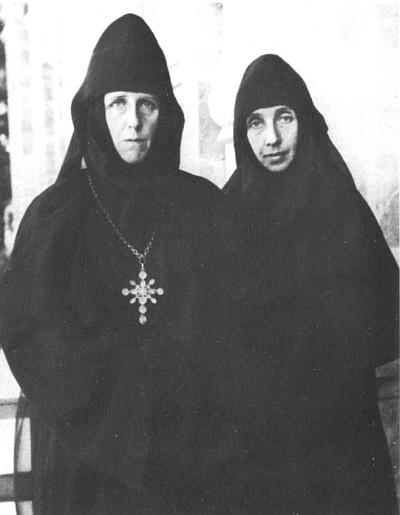 |
| (Left) the foundress of the sisterhood, Mother Mary (Robinson). |
 |
| (Right) Abbess Elizabeth of the Gesthemane Convent of St. Mary Magdalene |
These are perilous times for historical landmarks throughout the world. Each year our precious monuments of ‘living history’ fall victim to deterioration and decline, often due to lack of funds to maintain and repair them.
The Holy Land is no exception. The church is in a bad state of deterioration and ‘The Gethsemane Restoration Project’ was launched in 1994. Our goal is to repair and restore this famous landmark to its former magnificence. We ask for your help to achieve our aim.

